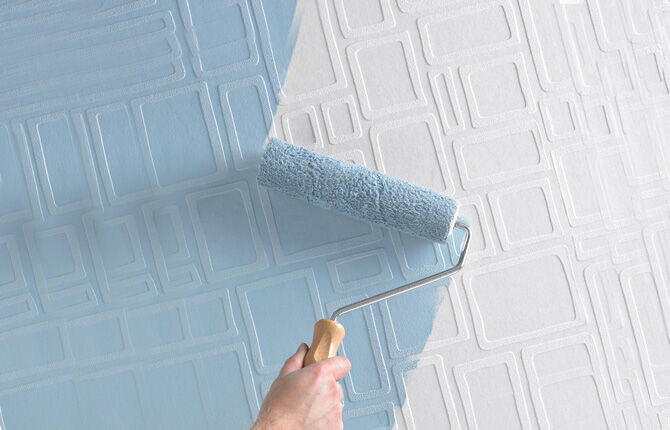Pasting and types of wallpaper for painting - the best ideas
Paintable wallpaper is a thick canvas, the outer surface of which has the appearance of decorative plaster.There are several types of this type of material. When choosing wallpaper for painting, take into account what it is made of.
The content of the article:
Paintable wallpaper: pros and cons
Manufacturers produce different types of wallpaper for painting. Their characteristics are different. The material has a number of advantages:
- High strength characteristics. The canvas is made of several layers. There are anti-vandal wallpapers that can be painted. They are resistant to mechanical damage.
- Easy to change color. Throughout the entire period of use, you can paint the canvas. This way you can change the interior without dismantling the old covering.
- Long service life. If minor damage occurs, it can be eliminated by applying a new coat of paint.
- Waterproofing properties. The outer layer makes the wallpaper resistant to moisture.
- Environmental friendliness. When used, the fabric does not emit substances harmful to health.
- Surface protection. Pasted wallpaper for painting prevents cracking of the walls. The adhesive holds the surface together.
- Smoothing out small irregularities. Due to the large thickness and textured surface, the strips can be mounted on walls with small irregularities.
The disadvantages of wallpaper for painting include the fact that when used, dust accumulates on textured surfaces. This requires more thorough cleaning.Paper strips are susceptible to fire when exposed to high temperatures or open flames.
Which option is better: painting or wallpaper for painting?
The owner independently determines what material to use. This will make it possible to create a surface that meets certain requirements. When choosing a finishing option, the following factors are taken into account:
- Installation method. The plastered and puttied surface is painted with a paint brush, roller or spray. The work is not difficult. Painting a wall requires minimal construction skills. Wallpapering and then painting makes the process of finishing the walls more labor-intensive.
- Price. You will need to pay for the rolls themselves, adhesive and paint. This makes the process more expensive than painting. Wallpaper has a long service life; subsequent repairs will require minimal costs.
- The resulting coverage. When wallpaper is pasted for painting, a textured canvas is obtained. By applying paint and varnish material to the wall, a smooth surface is obtained. To make it textured, it is necessary to apply an additional layer of decorative plaster.
- Local repairs. Damage to a small area of a painted wall requires the application of plaster. Scratches on wallpaper that can be painted can be hidden by replacing part of the canvas or painting over the damaged area.
To choose a finishing method, it is necessary to take into account the compatibility of the characteristics of the material and the place of application.
Paintable wallpaper: what to choose from
Manufacturers produce various types of materials for gluing walls. They differ in their characteristics. The installation method for products from different manufacturers may differ.Before use, you should read the instructions.
Paintable wallpaper is available in white. This way, after dyeing, a monochromatic canvas is obtained. Based on the material used, canvases are divided into several categories:
Roll sizes vary from product to manufacturer. This is taken into account in the calculations.
We bring to your attention the article - How to hang combined wallpaper.
Paper wallpaper: main characteristics
The paper web is made from recycled materials. This ensures its low cost. During production, several layers of paper are pressed together. This makes it possible to increase the density of the fabric. To prevent the paper from becoming soggy when applying paint, the outer layer is treated with specialized chemicals.
The textured surface is produced by embossing. The layers are pressed according to the pattern. This is how a canvas with the desired texture is obtained. Advantages of paper webs:
- Low cost.
- High air and vapor permeability.
- Environmental friendliness. When used, paper does not emit harmful substances that affect human health.
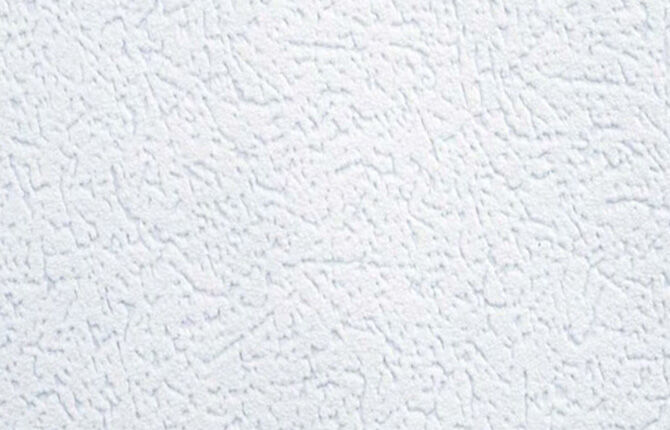
The disadvantages of the material are that paper products:
- They have a low degree of resistance to humid environments. When exposed to water, the paper becomes limp. Such wallpaper should not be used for painting in rooms with high humidity.
- Support combustion. Under the influence of high temperatures, such wall decoration ignites.
- They are characterized by low strength characteristics. When gluing and using the canvas is easy to damage.
Walls with a paper layer can be painted 3-5 times. After each application, the strength characteristics of the surface improve.
Non-woven wallpaper for painting: pros and cons
Nonwoven fabric is made from cellulose fibers. To bond the layers, adhesives that do not contain harmful substances are used. Therefore, non-woven fabric does not have a negative impact on health.
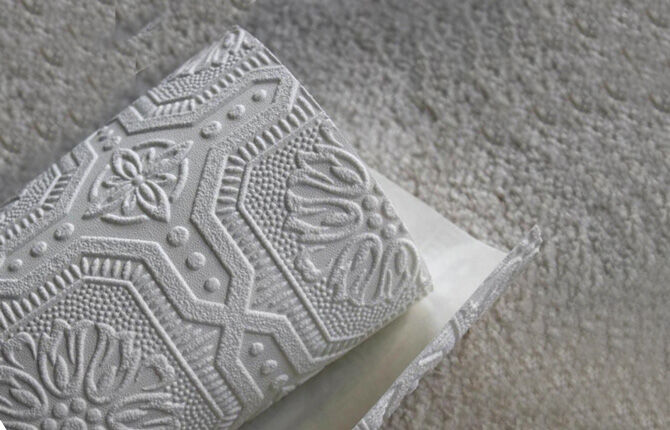
To improve strength during manufacturing, polyester is added to the composition. This makes non-woven products resistant to mechanical damage. The strips are easy to glue without fear of tearing or stretching. Non-woven surfaces have the following advantages:
- Air and vapor permeability.
- Resistance to mechanical damage. By using several layers simultaneously during production, tensile strength is achieved.
- Multiple dyeing. It is allowed to apply paint up to 7 times. After this, the depressions are filled and the texture is disrupted.
- Moisture resistance. When cleaning, it is permissible to wipe the surface with a damp cloth. The dense structure prevents the softening of the non-woven base when interacting with moisture.
Disadvantages include difficulty in applying paint with a roller or paint brush and flammability. For even distribution it is better to use a spray bottle. So the liquid is sprayed with compressed air under pressure.
Non-woven fabric is susceptible to fire when exposed to high temperatures or when exposed to open fire.
Features of vinyl wallpaper
Vinyl is applied to a non-woven or paper base. It is the outer side and forms the texture. Considering the advantages of vinyl, it is used for wall decoration. This coating has several features:
- Fire safety. Vinyl does not catch fire when exposed to high temperatures.
- Moisture resistance. The vinyl covering can be cleaned with detergents.The substances are applied with a sponge or hand sprayer. After cleaning, rinse off any remaining detergent with cold water. Do not use aggressive substances for cleaning. Violating this rule will result in damage to the vinyl.
- Pronounced texture. To improve adhesion after gluing, it is better to treat the vinyl with primer. You can create an even layer using a hand sprayer.
- Easy to stick. Vinyl strips easily remove wrinkles.
A person with minimal knowledge and skills in carrying out repairs can install vinyl wallpaper for painting.
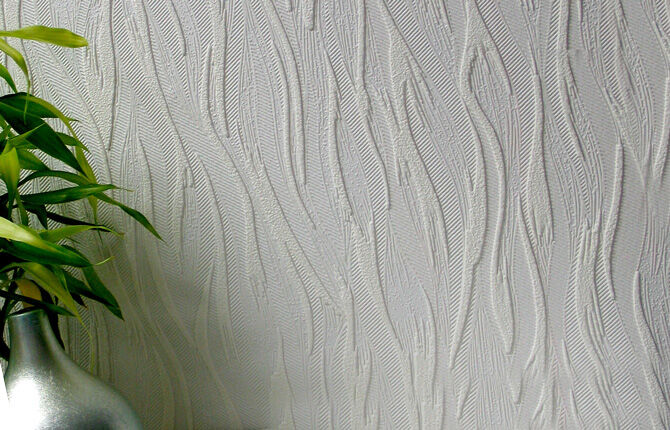
Fiberglass wallpaper is a popular new product
The fabric is made from fiberglass. Natural substances are used in production. They are heated in ovens to high temperatures. When processing the resulting composition, threads are created from which fiberglass is made. It has a textured surface and high performance. Advantages of glass wallpaper:
- Fire safety. Fiberglass wallpaper does not catch fire when interacting with open fire.
- Easy to care for. For cleaning use a sponge, rags, brush, etc.
- Resistance to mechanical stress. The surface can withstand regular cleaning without deteriorating in appearance.
- Long service life. Fiberglass wallpaper can be painted up to 20 times.
- Environmental friendliness. During operation, fiberglass does not emit harmful substances.
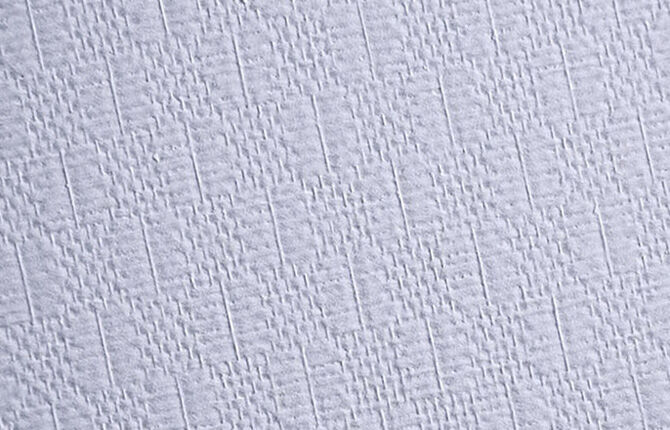
When working with glass wallpaper, it is necessary to use personal protective equipment (goggles, gloves).
Features of working with fiberglass wallpaper
Fiberglass is easy to install. Textured surface hides small irregularities on the wall. For gluing, you will need to carry out a number of preparations:
- Level the surface.Apply starting and finishing plaster. At the final stage, small depressions are filled with putty. To make the outer layer smooth, sand it with a trowel with a mesh or sandpaper.
- Apply primer. It is necessary to improve the adhesion of glass wallpaper to the wall. The primer is applied with a paint brush. To speed up the work, use a roller or sprayer.
- Make markings. The correct location of the lines in the vertical plane is checked with a plumb line or building level. For marking, use a simple pencil.
- Cut strips to size. The length of the segments is selected separately for each case, taking into account the distance from the floor to the ceiling. At the same time, for proper docking, a small margin is left on each strip.
After preparation, apply the adhesive to the wall. The pieces are applied and leveled, pressing them to the surface.
You can hang wallpaper before painting on one's own. Before choosing, take into account the characteristics of the material. For different types of wallpaper, the installation method is different. You should study the instructions supplied by the manufacturer.
Did you glue the wallpaper for painting yourself? What type of material was used? Leave comments. Bookmark the article and share it on social networks.
We also recommend watching a video that will reinforce your knowledge and answer any remaining questions.
